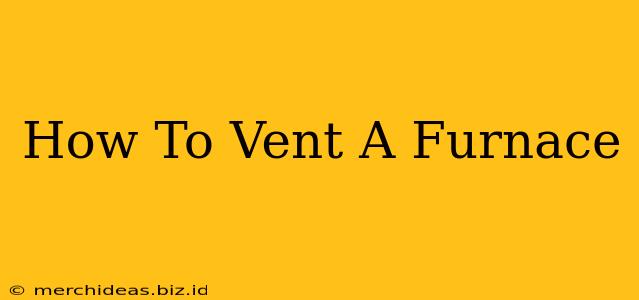Proper furnace ventilation is crucial for safety and efficiency. A poorly vented furnace can lead to carbon monoxide poisoning, a deadly threat, and significantly reduced heating performance. This comprehensive guide will walk you through the process of properly venting your furnace, covering various types of vents and troubleshooting common issues. Remember: If you're uncomfortable working with gas lines or electrical components, call a qualified HVAC professional. Safety should always be your top priority.
Understanding Furnace Venting Systems
Before diving into the how-to, let's understand the why. Your furnace needs proper venting to safely expel combustion byproducts. These byproducts, including carbon monoxide, are toxic and can build up in your home if not properly vented outside. There are several types of venting systems:
Types of Furnace Vents:
- Concentric Vent: This system uses two pipes, one inside the other. The inner pipe carries combustion gases away, while the outer pipe draws in fresh air for combustion. This is a popular choice for its efficiency.
- Single-Wall Vent: This system utilizes a single pipe to exhaust combustion gases. It's generally less efficient than a concentric vent and requires additional safety precautions.
- Power Venting: This system uses a blower to force exhaust gases out, often seen in high-efficiency furnaces. It ensures efficient removal, even in challenging conditions.
- B-Vent: This type of venting system is commonly used for older furnaces and is typically made of double-walled metal. It's known for its durability but may not be as efficient as newer options.
How to Inspect Your Furnace Vent
Regular inspection is vital to maintain safe and efficient furnace operation. Here's how to check your vent:
- Locate the Vent: Your furnace vent typically exits through the exterior wall of your home, often near the furnace itself. Look for a pipe or several pipes connected to your furnace.
- Check for Blockages: Carefully inspect the vent for any obstructions like leaves, nests, or debris. A clogged vent can restrict airflow and create dangerous conditions.
- Examine for Cracks or Damage: Look for any signs of damage, such as cracks or rust, in the vent pipe. Damaged vents need immediate repair or replacement to prevent leaks.
- Inspect the Connections: Ensure all connections between the furnace and the vent pipe are secure and airtight. Loose connections can lead to leaks and safety hazards.
Troubleshooting Common Venting Issues
While regular inspections can prevent many issues, problems can still arise. Here are some common problems and their solutions:
- Insufficient Draft: If your furnace is struggling to ignite or is frequently shutting down, it might indicate a problem with the draft. Check for blockages in the vent pipe and ensure proper airflow.
- Carbon Monoxide Leaks: This is a serious issue. If you suspect a carbon monoxide leak, immediately evacuate your home and call emergency services. Never attempt to diagnose a carbon monoxide leak yourself.
- Exhaust Gas Backflow: This occurs when combustion gases flow back into your home. It's usually a sign of a blockage or a faulty vent system. Contact a qualified technician immediately.
When to Call a Professional
While some simple maintenance, like checking for blockages, can be handled by homeowners, many venting issues require the expertise of a qualified HVAC technician. Call a professional if:
- You suspect a carbon monoxide leak.
- You detect damage to the vent pipe.
- You encounter any problems you cannot identify or fix.
- You are not comfortable working with gas lines or electrical components.
Regular maintenance and proper venting are key to ensuring your furnace operates safely and efficiently. By following these guidelines and contacting a professional when necessary, you can keep your home warm and safe throughout the heating season.
